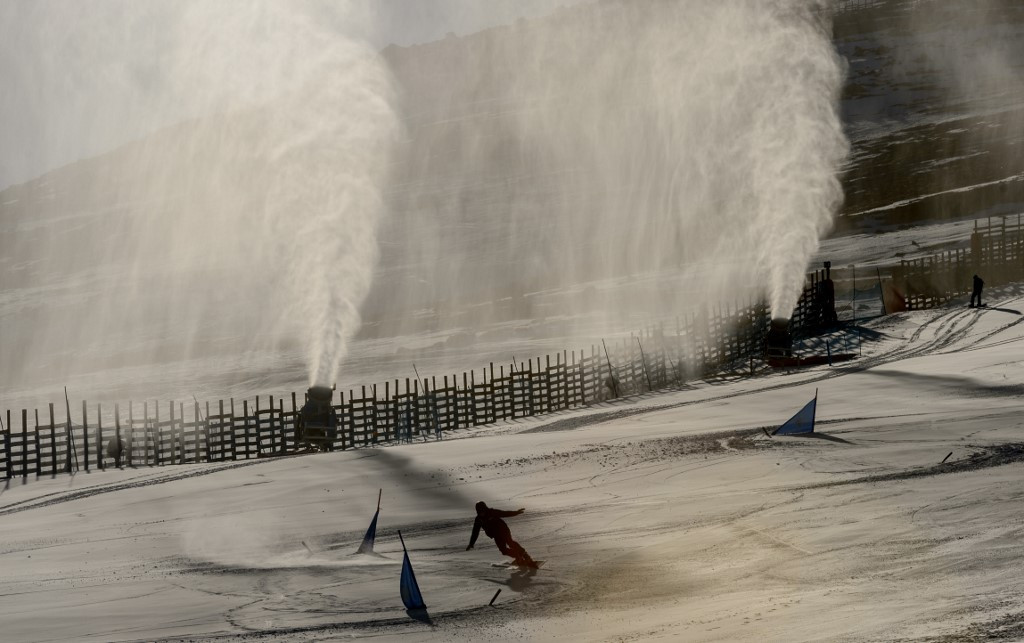Popular Reads
Top Results
Can't find what you're looking for?
View all search resultsPopular Reads
Top Results
Can't find what you're looking for?
View all search resultsClimate change forces Chile ski stations to make fake snow
Change text size
Gift Premium Articles
to Anyone
O
nce deep in powder this time of year, Chile's ski stations are fighting the ravages of climate change and pollution that have brought less and less snow to the central Andes.
Just a few decades ago, the Andes mountain range could be buried under four meters of snow, forcing the closure of access roads and requiring the use of tractors to get around.
But this year, it's snowed only three times in the Chilean Andes, and never more than 30 centimeters.
It's not just Chile affected, but the whole of the Andes where the area of snow cover in the central zone has diminished by five to 10 percent each decade, according to Raul Cordero, an academic at the University of Santiago.
"But it's not just snow cover that's decreasing, the thickness of the snow cover is also reducing," he said.
"So when we talk about a decrease of the cover of five to 10 percent, this probably signifies a much greater reduction in the volume of available snow over the Andes."
Rising temperatures mean the snow line -- above which snow never melts all year round -- keeps creeping upwards.
The snow melt is even more pronounced in the central zone due to pollution from the Chilean capital, one of the most contaminated urban areas in the region.
A recent study led by Cordero found that soot, or black carbon, from Santiago was settling in the Andes and accelerating the snow melt.
As it's black, it absorbs more solar radiation and heats up quicker.
"When this pollution is over the cities it poisons people and when the wind blows, this pollution goes and is deposited on the mountains and contributes to the snow melt," said Cordero.
Read also: Overseas visitors give winter tourism industry welcome lift
Essential snow cannons
The upshot is that Chile's ski stations have had a difficult season.
But thanks to the snow cannons, the erection of fences and a tailored piste management policy, the resorts have managed to stay open throughout a winter in which there has been almost no snow.
"All the ski centers in the central zone are without natural snow. However, thanks to the fabrication of snow we've been able to keep open pistes that without this fabrication would not have been able to stay open," Fernando Montenegro, the operations director at Andacor, which operates the El Colorado and Parque Farellones ski stations, told AFP.
El Colorado is 50 kilometers from Santiago and sits at 2,800-meters. It pumps out snow whenever the conditions allow it.
Low temperatures and high humidity is what's needed for the snow cannons to chug into gear and churn out snowflakes from water.
This technology has been around since 1994, but it's never before been in use as much as it is now -- and even then the ski station is only operating at 70 percent capacity.
But even if the situation gets worse, the ski stations will manage, according to Montenegro.
"There's no risk. However, we need to manage the snow and manage the water in the mountain range in a good way."
El Colorado has already invested almost $4 million in buying snow cannons and hopes to increase that to $10 million over the coming years.
Read also: Club Med Tomamu Hokkaido receives Green Globe certification
'Variety so important'
Last weekend, some 7,000 people descended on El Colorado where ski and snowboard national teams come to train -- although, they're not necessarily happy.
"If there's not enough snow, there's not as many hills. We don't get the variety, we don't get steepness, (or) different slopes: it's so important for us to have that variety," Megan Farrell, a member of the Canadian snowboard team, told AFP.
Amateur skiers also noticed the difference from previous years.
"You can see that the snow is harder. It's not very deep, there are a lot of stones and snow made by the cannons, which makes it feel like you're skiing on a different type of snow," said Chilean Rado Milosevic, 24.











